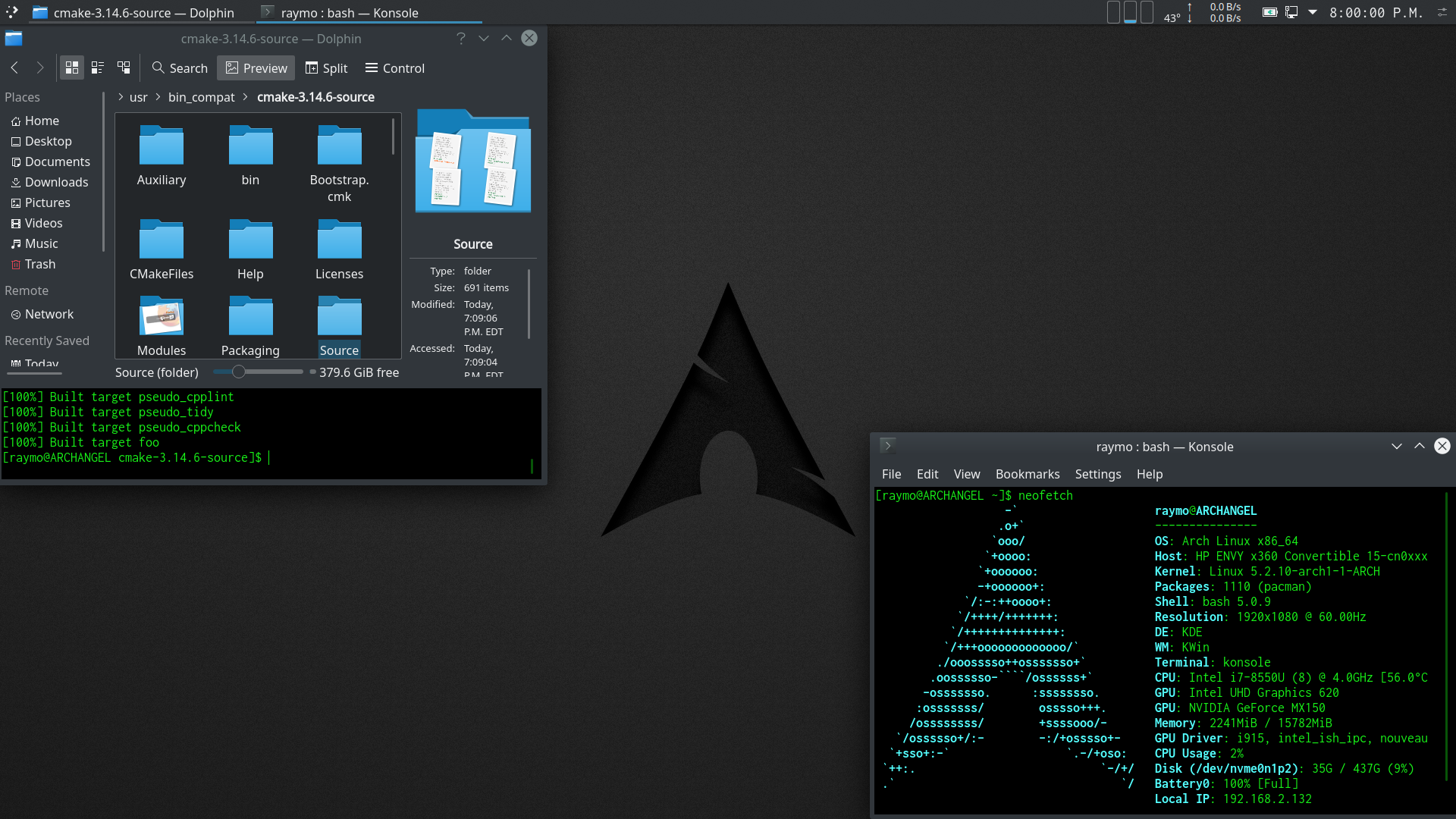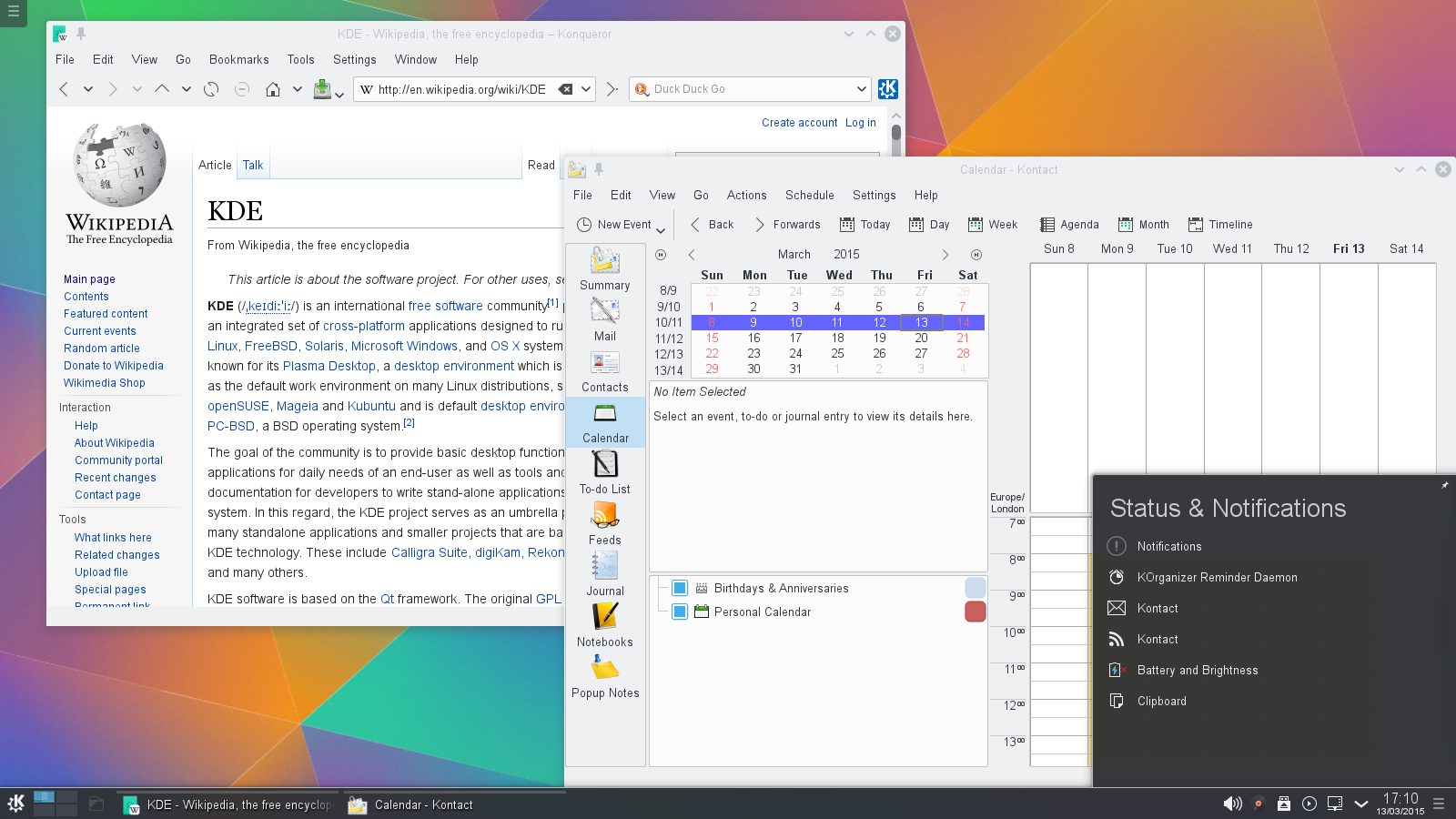|
KDE
KDE is an international free software community that develops free and open-source software. As a central development hub, it provides tools and resources that enable collaborative work on its projects. Its products include the KDE Plasma graphical shell, KDE Frameworks, and the KDE Gear range of applications including Kate, digiKam, and Krita. Many KDE applications are cross-platform and can run on Unix and Unix-like operating systems, Microsoft Windows, and Android. KDE is legally represented by KDE e.V. based in Germany, which also owns the KDE trademarks and funds the project. Origins KDE was founded in 1996 by Matthias Ettrich, a student at the University of Tübingen. At the time, he was troubled by certain aspects of the Unix desktop. Among his concerns was that none of the applications looked or behaved alike. In his opinion, desktop applications of the time were too complicated for end users. In order to solve the issue, he proposed the creation of a deskto ... [...More Info...] [...Related Items...] OR: [Wikipedia] [Google] [Baidu] |
KDE Gear
The KDE Gear is a set of applications and supporting libraries that are developed by the KDE community, primarily used on Linux-based operating systems but mostly multiplatform, and released on a common release schedule. The bundle is composed of over 200 applications. Examples of prominent applications in the bundle include the file manager Dolphin, document viewer Okular, text editor Kate, archiving tool Ark and terminal emulator Konsole. Previously the KDE Applications Bundle was part of the KDE Software Compilation. Extragear Software that is not part of the official KDE Applications bundle can be found in the "Extragear" section. They release on their own schedule and feature their own versioning numbers. There are many standalone applications like Krita or Amarok that are mostly designed to be portable between operating systems and deployable independent of a particular workspace or desktop environment. Some brands consist of multiple applications, such as Ca ... [...More Info...] [...Related Items...] OR: [Wikipedia] [Google] [Baidu] |
KDE Frameworks
KDE Frameworks is a collection of Library (computing), libraries and software frameworks readily available to any Qt (software), Qt-based software stacks or applications on multiple operating systems. Featuring frequently needed functionality solutions like hardware integration, file format support, additional graphical control elements, plotting functions, and spell checker, spell checking, the collection serves as the technological foundation for KDE Plasma and KDE Applications, KDE Gear. It is distributed under the GNU Lesser General Public License (LGPL). Overview KDE Frameworks is based on Qt, which enables a more widespread use of QML, a simpler JavaScript-based declarative programming language, for the design of user interfaces. The graphics rendering engine used by QML allows for more fluid user interfaces across different devices. Since the split of the KDE Software Compilation into KDE Frameworks 5, KDE Plasma 5 and KDE Applications, each sub-project can pick its ow ... [...More Info...] [...Related Items...] OR: [Wikipedia] [Google] [Baidu] |
KDE Projects
KDE Projects are projects maintained by the KDE, KDE community, a group of people developing and advocating free software for everyday use, for example KDE Plasma 5, KDE Plasma and KDE Frameworks or applications such as Amarok (software), Amarok, Krita or Digikam. There are also non-coding projects like designing the Breeze desktop theme and iconset, which is coordinated by KDE's Visual Design Group. Even non-Qt applications like GCompris, which started as a GTK-based application, or web-based projects like WikiToLearn are officially part of KDE. KDE uses Konqui, a Chinese dragon as their mascot. Overview As of today there are many KDE projects that are either stand-alone or grouped into larger sub-projects: * KDE Plasma 5, KDE Plasma Workspaces * KDE Frameworks (formerly KDELibs, KDE-Libs): A collection of library (computer science), libraries that provides Software framework, frameworks and functionality for Software developer, developers * KDE Applications, KDE Applications ... [...More Info...] [...Related Items...] OR: [Wikipedia] [Google] [Baidu] |
KDE Plasma
KDE Plasma is a Shell (computing), graphical shell developed by the KDE community for Unix-like operating systems. It serves as the interface layer between the user and the operating system, providing a graphical user interface (GUI) and workspace environment for launching applications, managing windows, and interacting with files and system settings. Plasma is designed to be modular and adaptable, with different variants tailored for specific device types, such as Plasma Desktop for personal computers, and Plasma Mobile for smartphones. Plasma was first introduced in 2008 as part of KDE Software Compilation 4, as a major technical overhaul, combining traditional desktop functionality with a widget-based system designed for flexibility and visual consistency. With the KDE brand repositioning in 2009, the KDE software compilation was split into three distinct projects: KDE Plasma, KDE Frameworks and KDE Gear, allowing each to develop and release on independent schedules. As of the ... [...More Info...] [...Related Items...] OR: [Wikipedia] [Google] [Baidu] |
Calligra Suite
Calligra Suite is a Graphic art software, graphic art and office suite by KDE. It is available for Desktop computer, desktop PCs, tablet computers, and smartphones. It contains applications for word processor, word processing, spreadsheets, presentation program, presentation, relational database management system, databases, vector graphics, and digital painting. Calligra uses the OpenDocument format as its default file format for most applications and can import other formats, such as Microsoft Office formats. Calligra relies on KDE Platform, KDE technology and is often used in combination with KDE Plasma Workspaces. Supported systems Desktops Calligra's main platform is Desktop computer, desktop PCs running Linux, FreeBSD, macOS, and Microsoft Windows, Windows, of which Linux is the best supported system. On desktop systems, the whole range of features is available. Smartphones and tablets , Calligra's efforts to create touchscreen-friendly versions are centered on reu ... [...More Info...] [...Related Items...] OR: [Wikipedia] [Google] [Baidu] |
Kate (text Editor)
The KDE Advanced Text Editor, or Kate, is a source code editor developed by the KDE free software community. It has been a part of KDE Software Compilation since version 2.2, which was first released in 2001. Intended for software developers, it features syntax highlighting, code folding, customizable layouts, multiple cursors and selections, regular expression support, and extensibility via plugins. The text editor's mascot is Kate the Cyber Woodpecker. History Kate has been part of the KDE Software Compilation since release 2.2 in 2001. Because of KParts technology, it is possible to embed Kate as an editing component in other KDE applications. Major KDE applications which use Kate as an editing component include the integrated development environment KDevelop, the web development environment Quanta Plus, and the LaTeX front-end Kile. Kate has won the advanced text editor comparison in '' Linux Voice'' magazine. , development had started to port Kate, along with Dolph ... [...More Info...] [...Related Items...] OR: [Wikipedia] [Google] [Baidu] |
KDevelop
KDevelop is a free and open-source integrated development environment (IDE) for Unix-like computer operating systems and Windows. It provides editing, navigation and debugging features for several programming languages, and integration with build automation and version-control systems, using a plugin-based architecture. KDevelop 5 has parser backends for C, C++, Objective-C, OpenCL and JavaScript/ QML, with plugins supporting PHP, Python 3 and Ruby. Basic syntax highlighting and code folding are available for dozens of other source-code and markup formats, but without semantic analysis. KDevelop is part of the KDE project, and is based on KDE Frameworks and Qt. The C/C++ backend uses Clang to provide accurate information even for very complex codebases. History KDevelop 0.1 was released in 1998, with 1.0 following in late 1999. 1.x and 2.x were developed over a period of four years from the original codebase. It is believed that Sandy Meier originated KDevelop. Ralf No ... [...More Info...] [...Related Items...] OR: [Wikipedia] [Google] [Baidu] |
Matthias Ettrich
Matthias Ettrich (born 14 June 1972) is a German computer scientist and founder of the KDE and LyX projects. Early life Ettrich was born in Bietigheim-Bissingen, Baden-Württemberg, West Germany, and went to school in Beilstein, Württemberg, Beilstein while living with his parents in Oberstenfeld. He passed the Abitur in 1991. Ettrich studied for his MSc in Computer Science at the Wilhelm Schickard Institute for Computer Science at the University of Tübingen. Career He currently resides in Berlin, Germany. He is currently focused on advising start-ups and corporations on digital transformation and in sound technical decision-making. Free software projects Ettrich founded and furthered the LyX project in 1995, initially conceived as a university term project. LyX is a graphical frontend to LaTeX. Since LyX's main target platform was Linux, he started exploring different ways to improve the graphical user interface, ultimately leading him to the KDE project. Ettrich found ... [...More Info...] [...Related Items...] OR: [Wikipedia] [Google] [Baidu] |
Amarok (software)
Amarok is a free and open-source music player for Linux, macOS, Windows, and other Unix-like operating systems. Amarok is part of the KDE project, but it is released independently of the central KDE Software Compilation release cycle. Amarok is released under the terms of the GPL-2.0-or-later. History Amarok is one of the oldest Linux music players in active development, being started in 2003. The program was originally stylized as amaroK, after a Mike Oldfield album of the same name. The artwork references Amarok, a wolf in Inuit mythology. The app's capitalization was changed to Amarok in June 2006. A new major version of Amarok, version 2.0, was released on December 12, 2008. On June 3, 2009, version 2.1 was released, which reintroduced some of the 1.4 features which had been missing from the initial 2.0 release, and introduced some features such as native ReplayGain support. Version 3.0 of Amarok was released in April 2024, after a six year hiatus of major updates. I ... [...More Info...] [...Related Items...] OR: [Wikipedia] [Google] [Baidu] |
Krita
Krita ( ) is a free and open-source software, free and open-source raster graphics editor designed primarily for digital art and 2D animation. Originally created for Linux, the software also runs on Windows, macOS, Haiku (operating system), Haiku, Android (operating system), Android, and ChromeOS, and features an OpenGL-accelerated canvas, color management, colour management support, an advanced brush engine, non-destructive Layers (digital image editing), layers and masks, group-based layer management, vector artwork support, and switchable customisation profiles. The software is also available as paid software, distributed on Microsoft Store, Steam (service), Steam, Epic Games Store, and Mac App Store. The paid version has automatic update and used to support the development of the software. Name The project's name "Krita" is primarily inspired by the Swedish language, Swedish words , meaning "crayon" (or chalk), and ' which means "to draw" as well as Sanskrit कृत (kṛ ... [...More Info...] [...Related Items...] OR: [Wikipedia] [Google] [Baidu] |






